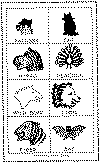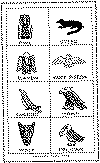By Robert De Groat
 Patrol totems may be readily designed by using the
Patrol emblem as the top figure and telling the story of the Patrol on the remainder of
the pole. The pole may be used in front of the tent as an ornament, or the tent pole may
be in the design of an Indian design. It may even happen that your Patrol is extra
ambitious and wants to carve two poles as main features of a simple gateway to the
entrance of the tent, especially for extra points in camp tent inspection.
Patrol totems may be readily designed by using the
Patrol emblem as the top figure and telling the story of the Patrol on the remainder of
the pole. The pole may be used in front of the tent as an ornament, or the tent pole may
be in the design of an Indian design. It may even happen that your Patrol is extra
ambitious and wants to carve two poles as main features of a simple gateway to the
entrance of the tent, especially for extra points in camp tent inspection.

Masks
Very often Patrols sit together at the council ring and they like to have small totems designating their respective places. It also makes a very ornamental council ring. If the Patrol votes upon it, the pole may be brought to the city placed in the Patrol den as a camp trophy.

Animal Base of Totem Pole
By all means make your emblem the dominating figure. Perhaps in your Patrol history you have hiked in the mountains. Include the mountains in your design. Possibly your Patrol has won some Inter-Patrol contest or championship--fine! Use this as a subordinate idea in some part of part of your pole.

Grave Post, Wrangel, Alaska
Several very fine illustrations of completed poles are included in various parts of this book. See if you can read their story.
A Scout can adapt his Patrol name or animal correctly into the feature part of the totem. In the preceding chapter it was noted that the tribes in the different sections of the country had various totems which correspond to patrol names. Therefore you can connect your Patrol with some tribe and find out all the little legends and stories of war parties or battles and brave deeds that were accomplished by your predecessors.
 Your Patrol emblem is probably illustrated in silhouette form in the
Handbook for Boys, but no details are given as to the possible ways it may be carved.
However, good detailed illustration of animals and birds can be found in many
books. It is a good thing to use your Patrol colors when paint the principal
features.
Your Patrol emblem is probably illustrated in silhouette form in the
Handbook for Boys, but no details are given as to the possible ways it may be carved.
However, good detailed illustration of animals and birds can be found in many
books. It is a good thing to use your Patrol colors when paint the principal
features.
There are several names of Patrols in the Handbooks that do not appear in American Indian lore but they furnish additional ideas for carving. The reverse is also true. There are names of animals and objects in Indian lore that might easily be adopted as Patrol names and totems or emblems.
 Take a glance through the lists which have been prepared by sections and tribes of the country for your convenience. If
your Patrol needs a name, you will find a good one in these lists. Select several
logical totems and submit them to the members of your Patrol for a vote. The result
will be an appropriate Patrol name and a totem which you will know is authentic for your
particular locality.
Take a glance through the lists which have been prepared by sections and tribes of the country for your convenience. If
your Patrol needs a name, you will find a good one in these lists. Select several
logical totems and submit them to the members of your Patrol for a vote. The result
will be an appropriate Patrol name and a totem which you will know is authentic for your
particular locality.
 The
totem shown here is a record of the Troop by the Zodiac signs for each month,
starting with the sign of the Ram in the month of March, 1925, and reading down
one panel (See No. 4).
The
totem shown here is a record of the Troop by the Zodiac signs for each month,
starting with the sign of the Ram in the month of March, 1925, and reading down
one panel (See No. 4).
There a pocket in the wood directly under the eagle, whose name is Solum Slaturn, or Stands Alone. He is on duty--to guard the records of the Troop which are in this hidden pocket . These records of each Scout are just as they are given at the time of mounting the eagle. The Four Stages of the Moon are shown on the four sides of the head of the pole, representing the week-end hikes.
The vine on one side of the pole represents the Troop, each leaf representing a Scout who had worked on the pole. As the Scout advanced in carving he had a chance at the pole, which was considered an honor. Each Scout who worked acceptably on the pole had his picture set in it.






